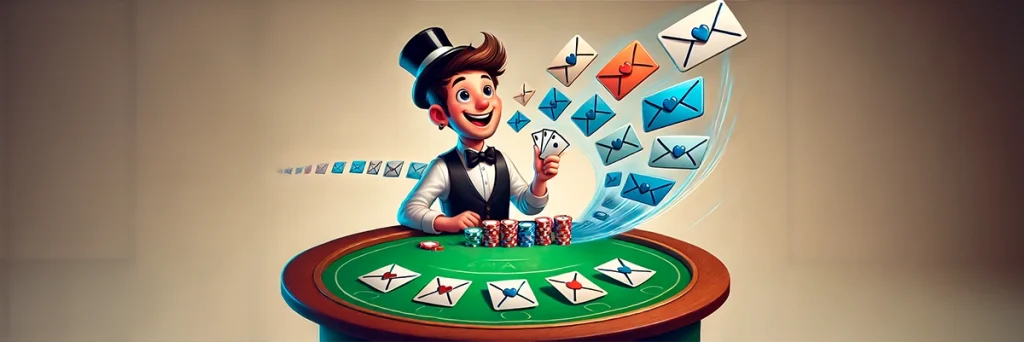Bcc email, or blind carbon copy, is the technique used to send emails to several recipients at once, keeping the addresses of all of them hidden. In other words, the recipient of a bcc email receives the message as if it were their own.
In some situations, this is useful. For example: you need to send an email inviting several people to a personal event without everyone having access to each other’s addresses.
Or the board of a company sends a notification about an updated security policy to all employees, reducing the risk of unwanted ‘replies to all’ that can crowd inboxes.
bcc email is nothing if not practical. And for this very reason, there are people who use this functionality to send email marketing campaigns.
But is the use of this tool ideal for those who work with bulk emails?

Table of contents
Is Bcc email suitable for sending bulk emails?
Sending mass emails is an action monitored by the spam filters of the recipients’ providers.
This involves an ecosystem of in-depth technical and behavioral analyses, which involve blocking domains and IPs, as well as blacklisting senders.
In short, it means that every sender of bulk emails must comply with the providers’ security protocols. If they don’t, they will be classified as a spammer.
These security protocols are the SPF, DKIM and DMARC records, which are authentications that prove the origin of emails, i.e. where they come from.
The bcc email technique has none of these authentications. In addition, each provider allows a daily sending limit, precisely to mitigate the sending of large quantities.
In other words, you can send a large (and limited) volume of emails through the bcc system, but at some point, you will receive penalties and restrictions for spammer behavior. And you don’t want that, do you?
The use of bcc email is only suitable for personal situations. In other words, nothing involving marketing, sales or business messages.
Prefer email marketing tools to bcc email
If your company is small and you work with small email lists, there are some good free email marketing tools on the market.
Here are a few:
- Hubspot: the tool is free for up to 2,000 sends per month.
- Mailchimp: the free plan covers 1,000 sends for up to 500 contacts/month.
- SendPulse: the platform allows you to send 15,000 emails to up to 500 subscribers per month.
- Brevo: the tool allows up to 300 emails per day, which totals 9,000 sends per month.
- MailerLite: the platform offers free mailings to lists of up to 1,000 contacts/month.
Whichever platform you choose, the features that an email marketing tool offers, even if they are free, will be much more complete than using bcc email.
All the platforms follow the providers’ security protocols, as well as being able to send bulk emails in seconds.
With the bcc email technique, you would have to enter contact after contact manually. This takes up unnecessary time and effort!
It’s worth remembering that email verification, among other good practices, is fundamental to guaranteeing high deliverability rates for your campaigns in recipients’ inboxes.
This means that a contact list must remain clean; free of bounces and any type of invalid email.
This way, campaigns are not at risk of being blocked and you are free from being classified as a spammer due to high bounce rates.
However, if your company doesn’t yet have a list containing a thousand emails, you can work with SafetyMails’ free email verifier. Find out more below!
How the free SafetyMails checker works
The free checker is very useful for small teams that need to communicate with leads via email.
SafetyMails has a quick check feature, where you enter the emails one by one to see if they are valid or not.
This gives your marketing team a better chance of generating results and your sales team a better chance of closing deals, since they’ll be communicating with real, active leads!
Go here and use the free verification tool to boost your email marketing!
Simply enter the address in the blank field and then click on “verify”.
If your list has a thousand emails or more, open your free SafetyMails account and get 100 credits to try out the platform! Each credit is equivalent to verifying one email.
With your list sanitized, you can start planning your campaigns! And don’t forget: using bcc email to send marketing communications is a waste of time.
Conclusion
As an extremely practical means of communication at a low cost, email is one of the communication channels most used by professionals and companies who want to nurture a good relationship with their leads.
However, many people insist on using email marketing in the wrong way, based on functionalities that are often not in line with good sending practices.
The result is the infamous “cheap gets expensive”, as the providers’ spam filters are highly discerning and trained to find emails that don’t follow the appropriate sending rules.
And these search criteria are even more refined when it comes to mass mailings.

FAQ
What is bcc email and how is it different from cc email?
Bcc email stands for blind carbon copy email. In other words, messages sent to groups of people have their addresses hidden. Thus, the sender receives the message as if it were an individual message. Cc email, on the other hand, is carbon copy. It means email with a copy, where recipients can see all the addresses that received the message.
Why isn’t bcc email suitable for sending bulk emails?
Sending bulk emails via hidden copies is an action that does not comply with the security protocols of the recipients’ providers. Because it is not a professional action and for other reasons, such as the number of sends (each provider has a limit), senders end up being classified as spammers.
Why is it better to use a mailing tool than bcc?
Email sending tools – free or paid – offer their own features that senders need in order not to be classified as spammers and thus achieve their email marketing objectives.



